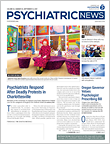Binge drinking may be an early indicator of vulnerability to alcohol use disorder (AUD) and should be carefully assessed as part of a clinical evaluation, suggests a study published on August 4 in AJP in Advance.
“Identifying early phenotypic differences between vulnerable individuals and healthy control subjects could help identify those at higher risk [for AUD],” wrote Joshua L. Gowin, Ph.D., a postdoctoral researcher at the National Institutes of Health in Bethesda, Md., and colleagues.
Defined as a pattern of drinking that brings the blood alcohol level to 0.08 g/dL or above, binge drinking may indicate vulnerability to AUD, according to researchers.
The study consisted of 159 young social drinkers who had taken part in an experimental laboratory session where they self-administered alcohol. To be included, participants must have consumed at least five drinks on at least one occasion previously.
After the participant ate a standard meal, an intravenous catheter was inserted into a vein in the subject’s forearm. Alcohol self-administration was conducted using the computer-assisted alcohol infusion system software, which controlled the rate of infusion of 6 percent v/v (volume/volume) alcohol in saline for each person, using a physiologically based pharmacokinetic model for alcohol distribution and metabolism that accounts for sex, age, height, and weight.
Researchers tested the hypothesis that risk factors for AUD—including family history of alcoholism, male sex, behavioral impulsivity, and low level of response to alcohol—would predict the rate of binging during an individual alcohol consumption session.
Overall, 60 participants reached a binge-level exposure. A greater percentage of relatives with alcoholism (hazard ratio: 1.04), male sex (hazard ratio: 1.74), and higher impulsivity (hazard ratio: 1.17) were associated with a higher rate of binging throughout the session. Participants with all three of these risk factors had the highest rate of binging throughout the session compared with the lowest risk group (hazard ratio: 5.27). Level of response to alcohol was not a significant predictor of the rate of binging throughout the session.
The study demonstrated that alcohol consumption patterns of young social drinkers at risk for AUD varied markedly from young low-risk drinkers. Researchers found that vulnerable drinkers showed higher rates of binging throughout the session and a greater overall exposure to alcohol.
To the investigators’ knowledge, this is the first large pharmacokinetically controlled study to suggest that risk factors for AUD may lead to different patterns of drinking in young social drinkers who have not yet developed the disorder.
The study was supported by the National Institute on Alcohol Abuse and Alcoholism Division of Intramural Clinical and Biological Research. Development of the software used for the intravenous alcohol self-administration session was supported by Sean O’Connor, M.D., of the Indiana Alcohol Research Center. ■
“Vulnerability for Alcohol Use Disorder and Rate of Alcohol Consumption” can be accessed
here.
